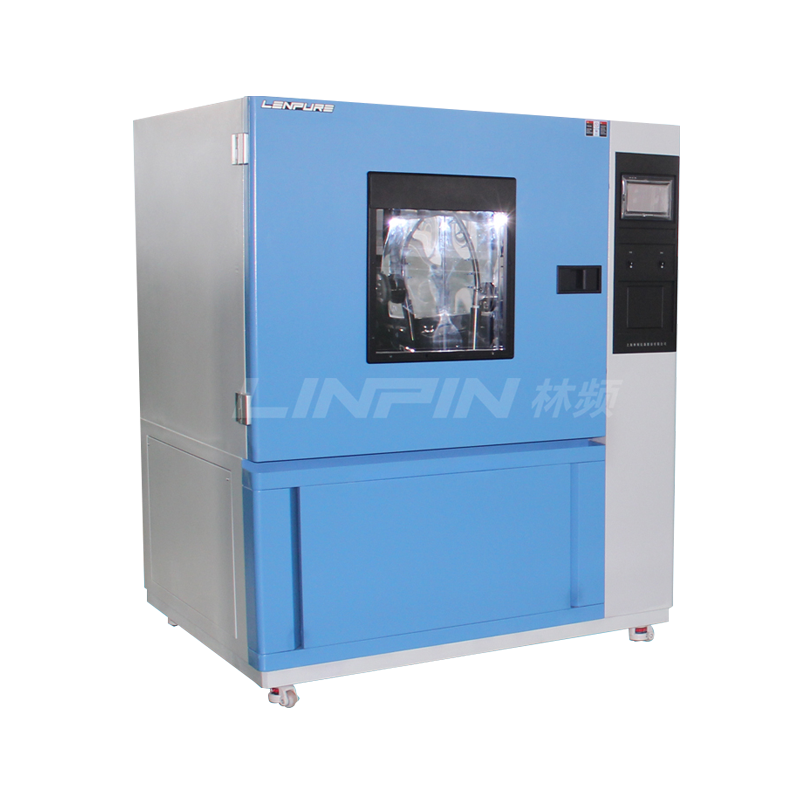

The rain test chamber accurately simulates the IPX5 and IPX6 waterproof tests. The nozzle diameter is 6.3mm/12.5mm. The water flow rate is 12.5L/min or 100L/min. The water pressure is 30kPa/100kPa. The vertical spray height is 2.5m/8m. The timing is strictly based on the surface area (1min/㎡ and ≥3min). The 3-meter spray distance is adjustable to ensure the reliable waterproof performance of automotive lamps.

Overview of product protection level test chamber
The rain test chamber is designed specifically for testing the waterproof performance of external lighting and signaling devices as well as the outer shells of automotive lamps. This test chamber can meet the requirements of the IPX5 and IPX6 rain tests, and is therefore also commonly referred to as a splash water test device.
Detailed explanation of IPX5 test method
【Test conditions and requirements】
The IPX5 test, also known as the splash water test, is an important part of evaluating the waterproof performance of external lighting and signaling devices as well as the outer shells of automotive lamps. In the rain test chamber, this grade of test aims to verify whether the product can withstand the impact of water flow ejected from a nozzle, while ensuring that the direction of the water flow is within a range of 28.3° from the vertical line. Through this test, we can gain a deeper understanding of the waterproof effect of the product, thereby providing strong support for further optimization of the product.
The nozzle diameter needs to reach 6.3mm.
The water flow rate is controlled within the range of (12.5±0.625) L/min.
The nozzle water pressure is about 30kPa (0.3bar), which is equivalent to a free spray height of 2.5m in the vertical direction.
The test time is determined based on the surface area of the test electrical appliance, with 1min required per square meter, and the total time is not less than 3min.
The distance between the nozzle and the surface of the test electrical appliance is about 3m, but this distance can be appropriately shortened when it is necessary to spray the electrical appliance from various directions.
Detailed explanation of IPX6 test method
【Test operation steps】
In the IPX6 test, we follow a series of strict operating steps. First of all, we ensure that the nozzle diameter reaches 6.3mm, which is one of the key parameters of the test. At the same time, we strictly control the water flow rate to keep it within the range of (12.5±0.625) L/min to ensure the accuracy of the test. In addition, the nozzle water pressure is about 30kPa (0.3bar), under which the spray can reach a free height of 2.5m in the vertical direction, thus effectively simulating the real spray water situation.
During the test, we determine the test time based on the surface area of the test electrical appliance, with 1 minute of spraying required per square meter of surface, and the total test time is not less than 3 minutes. At the same time, we maintain a distance of about 3 meters between the nozzle and the surface of the test electrical appliance, but this distance can be appropriately shortened in some cases where it is necessary to spray the electrical appliance from different directions.
【Specific test conditions for IPX6】
In the IPX6 test, we have set the following key conditions. First of all, the nozzle diameter must reach 12.5mm, which is a basic requirement for the test. Secondly, the water flow rate needs to be controlled within the range of (100±5) L/min to ensure the accuracy of the test. In addition, the nozzle water pressure is set to about 100kPa (1bar), under which the spray can reach a free height of 8m in the vertical direction, thus approximating the real spray water conditions.
During the test, we determine the spraying time based on the surface area of the test electrical appliance, ensuring that each square meter of surface is sprayed for at least 1 minute, and the total test time is not less than 3 minutes. At the same time, we keep the distance between the nozzle and the surface of the test electrical appliance between 2.5 meters and 3 meters, but this distance can be adjusted accordingly in some special cases. These detailed condition settings are designed to ensure the rigor and accuracy of the IPX6 test.